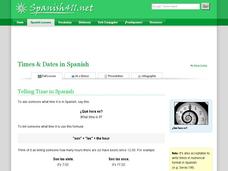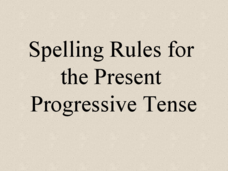Curated OER
Direct & Indirect Object Pronouns
There is a wealth of information provided here about direct and indirect object pronouns. Consider breaking these complex grammatical concepts into smaller chunks so that your Spanish language learners do not become overwhelmed. The At a...
Houghton Mifflin Harcourt
Family Time: Extra Support Lessons (Theme 5)
Provide extra support with a unit that follows a teach, blend, guided practice, and practice/apply routine to reinforce reading, grammar, vocabulary, and writing skills. Reading and writing lessons include supporting details,...
California Department of Education
Possible Careers
Is a STEM career the right choice for me? Lesson four in a six-part career and college readiness series introduces seventh graders to the world of STEM occupations. Individuals use their Holland code results to select, research, and...
Pearson
Conclusions: Must, Have (Got) To, May, Might, Could, Can't
Is this presentation the perfect addition to a grammar unit? It must be! Learn about drawing conclusions with different levels of certainty, using must, might, could, and can't.
K12 Reader
Eating with Adverbs
All the sentences on this adverb worksheet share a focus on eating—where, when, and how people are dining.
Curated OER
Times & Dates in Spanish
Use this information, presentation, and infographic to build several lessons on telling the time and expressing the date in Spanish. The information is broken into topics and includes many examples and exceptions to the standard rules....
Curated OER
How Do Adjectives Improve Writing?
Using adjectives to create vivid descriptions is the focus of exercises in this resource. A cloze reading activity asks class members to add missing adjectives to passages from Mark Teague's The Lost and Found. They then read...
Elementary AMC
Earth Day Grammar
Ensure you have a grammatically correct Earth Day with this series of task cards. Covering topics ranging from parts of speech and alphabetizing, to affixes and complete sentences, these Earth-themed exercises are a fun way for...
Curated OER
Writing Questions With Who, What, And Be (Is And Are)
In this writing questions worksheet, students read the guidelines for writing questions about people and things using who, what, and the verb "to be." They fill in the blank in 10 question examples using who or what and a form of "be"...
Curated OER
Linked For Life! Linking Verbs and Predicate Nouns
In this predicate noun worksheet, students identify predicate nouns in sentences. In this word/predicate noun recognition worksheet, students draw lines under the nine answers.
Curated OER
Ellie's Diary 1 The Future Tense
In this reading worksheet, students read a diary entry for information and answer comprehension questions. In this short answer worksheet, students answer eleven questions.
Curated OER
Worksheet 9: There Is/Are
This nifty activity has learners identify locations on a map. Once students have identified the location, they use a word bank to fill in the blanks on the worksheet. This activity could be used with elementary children or ESL students.
Curated OER
Reading Passage and Verb Tense
In this language arts interactive worksheet, 3rd graders read a passage about seabirds and answer questions. Students answer 25 interactive online questions.
Curated OER
Misused Verbs: Will/Would
In this misused verbs instructional activity, learners read about correct usage of will and would, then choose one to correctly fill in blanks in sentences. An answer key is included.
Curated OER
Future Tense
When do you use the future tense? In French, there are two ways to say things in the future tense. This short, eight-slide PowerPoint introduces both options and provides just a few examples. To strengthen this presentation, add...
Virginia Department of Education
Using Subject-Verb Agreement with Intervening Phrases and Clauses
Learners practice subject-verb agreement in a practical activity. As a class, they see examples of subject/verb agreement provided by the instructor. In groups, they assemble the provided subject/verb cards and make creative sentences...
Curated OER
The Parts of Speech
Identify action verbs and decide whether they are transitive or intransitive. After labeling fourteen sentences and their verbs, learners move on to distinguish action verbs from linking verbs in twenty additional sentences. The...
Curated OER
Visible Speech: What is a Sentence?
Use this straightforward presentation as a basic guide to your grammar unit. With explanations of the parts of a simple sentence (subject, verb, direct object), the slideshow is a good way to reinforce students' prior knowledge about...
Curated OER
Preterite vs. Imperfect #9
What is the difference between the preterite tense and the imperfect? Compare the two, and then give your class this practice half-sheet. There are 12 verbs in parentheses, and your class must decide which should be in the preterite...
Curated OER
http://autoenglish.org/gr.may3.pdf
Modal verbs of probability express what could or may happen. The class will look at 15 sentences and then choose which verb of probability fits best in each phrase. Then they write four phrases using accurate verbs in the present tense....
Curated OER
Time Expressions Active Voice
Can you recall the six verb tenses? Review the six verb tenses with this informational handout. While there is no practice opportunity provided, several examples, and clue words are shown for each tense. Walk through this guide with your...
Curated OER
Present Perfect 2
Get your budding grammarians ready to finish sentences. There are 12 sentences on this online worksheet, and all of them are missing their present perfect verbs. All they need to do is type the correct verb into each blank and then click...
Curated OER
Saber vs. Conocer #1
What is the difference between the verb saber and conocer? Although they are similar, they are used differently. Test your language learners with this short exercise. They complete the provided dialogue by completing the incomplete...
Curated OER
Spelling Rules for the Present Progressive Tense
Help your learners change words to the present progressive tense using this presentation. Using simple words like read, leave, and sit, they add an ing ending properly to a list of words. This is a good way to introduce this topic.























